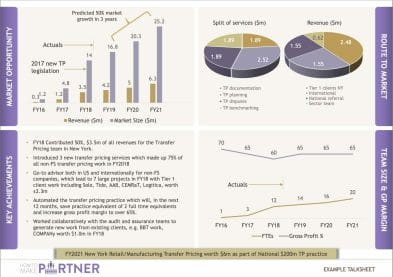You’ve poured your heart and soul into writing your Business Case for partnership. Your challenge is now to condense your ‘war and peace’ Business Case (and we have seen firms which literally require their partnership candidates to submit business cases which are over 50 pages long) into a 10-minute persuasive, engaging and impactful presentation for their partnership panel interview. In this article, we share the tips that have helped our clients make a persuasive and impactful pitch for their Business Case for partnership.
What is the partnership panel interview?
In some firms, typically mid-tier law firms and small accountancy and law firms, you may only need to submit a written Business Case. Or sometimes, not even that! However, most partnership admissions processes include a partnership panel interview. This is where you will pitch your Business Case, and typically be assessed on your Personal Case simultaneously. I.e. Are you someone that the partners want in the partnership? From our experiences with clients, you only get 10 minutes in your partnership panel interview to pitch it. After you have presented your partnership Business Case, the rest of your partnership panel interview will normally be questions on and around your Business Case AND sometimes your Personal Case. Some firms split the partnership panel interviews between the Personal and Business Case. However, you should always expect that the questions you receive at your partnership panel interview will be assessing both.
1. Start with a one-page Talk Sheet
When faced with a PowerPoint slide, cramming in all the detail you think may help can be tempting. This is a massive trap and one which will trip you up. Before you start your presentation, you must ensure that you can reduce your Business Case for partnership into, ideally, 4-5 visuals and a small amount of text. These are the essential elements of what we call a one-page Talk Sheet.
We get our clients, from both Big 4 firms and small firms, to crystallise their Business Case onto a one-page Talk Sheet. In fact, this approach has become so successful that the one-page Talk Sheet idea has often been adopted in a widespread manner in the Big 4 firms where we have introduced the method.

But this isn’t just any old one-page document. After all, you can fit many words on an A4 piece of paper. No, this is where you crystallise your Business Case down to just 3-6 visuals and 3-6 short bullet points of text. See the example on the left of a Talk Sheet. This discipline forces you to become incredibly clear about the benefits of your Business Case. As a result, it becomes much easier to pitch then and successfully communicate the commercial proposition of your Business Case for partnership to your partners.
Wouldn’t your life be easier if you could grab the template we used to assemble this template? This one-page Talk Sheet template has been professionally designed and is available to our members of Progress to Partner.
Luckily for you, you can download this Talk Sheet template free of charge by clicking here.
Our course “How to Build a Cast-Iron Business Case for Partner” (included within Progress to Partner for premium members) takes you through step-by-step how to put together your Talk Sheet.
As well as help on your Talk Sheet, we think membership of Progress to Partner is a must-have in your arsenal of tools and guidance to help with your career progression. There is also a section on the Partnership Admissions process with guides and recordings to help you navigate being on Partner Track and taking the final step up to Partner. Check it out!
Click here to download a template of a one-page Talk Sheet you can use right now to recreate your own one-page Talk Sheet.
2. This isn’t the time to go through your CV
You’ve had a great career to date. Therefore, it is entirely understandable that you want to share as much of the great stuff as possible. However, unless expressly asked to do so at your partnership panel interview, this is not the time to share your CV. Who cares whether you went through your firm’s elite leadership programme? Unless some aspect of your past really strengthens your argument for why I should be made up to partner, leave it out.
I’ve often deleted out of people’s Business Case presentations things like:
- Their degree and what institution they obtained it from
- Their family circumstances
- Their age
- Their hobbies and interests.
What matters is very simple, can you convince your partnership that you are a great addition to the partnership? That you will:
- Bring in profitable work for your department and others in the firm
- Build a sustainable client portfolio and leave a positive legacy for the firm
- Develop a strong pipeline of talent beneath you
- Be a good fit culturally for the partnership and complement the existing partners in the firm; and
- Are in it for the long term and are committed to the long-term goals and vision of the firm
Our course “How to Build a Cast-Iron Business Case for Partner” (included within Progress to Partner for premium members) will take you through what needs to go into your presentation. It even includes a suggested PowerPoint slide deck to ensure your presentation is succinct. Check it out!
3. Quantify your claims
Anyone can articulate a good Business Case where they promise they will achieve the earth. Additionally, anyone can also claim to be:
- Leading
- Experienced
- Great at developing business
- Excellent team leader
Words are very cheap. But it is far more about what you have done and how you evidence what you have done, which matters. Any claim you make about your prowess in your Business Case needs to be backed up by proven and quantifiable evidence. Before you submit your Business Case, look through it and eliminate any unsubstantiated claims.
Click here to download a guide to creating a cast-iron Business Case for partnership (email required)
4. Storyboard your business case
I’ve talked in this post about the importance of your story. However, when you are confined to an often standard slide deck template, your story becomes very important. If you were to take your partners through a story to tell them about the opportunity they will gain if they promote you to partner, what would you want to tell them? Now reduce that down to only 3 things. You may hesitate about reducing it down to three things. After all you have so much good stuff that you want to tell your partners. I promise that if you get crystal clear about the few things that answer the ‘why should you promote me to partner’, your Business Case will strengthen.
In Progress to Partner is a recorded masterclass on how to ace your Partner Panel. Here is a short snippet from that masterclass discussing ditching the slides and structuring your presentation.
Here is a snippet from the masterclass:
Click here to download a guide to creating a cast-iron Business Case for partnership (email required)
5. Consider ditching the slides altogether in favour of handouts or a Talk Sheet
Who said you must use a PowerPoint deck in your partnership panel presentation? Remember that the purpose of the presentation is to engage with your partners to demonstrate that you will be a great bet for partnership. This means you may consider ditching your slides altogether in favour of 1-2 Talk Sheets.
Click here to download a template of a one-page Talk Sheet you can use right now to recreate your own one.
6. Keep it visual
You typically only have 10-15 mins to present your Business Case. How you use this time is up to you. However, the more you can use visuals to show the commercial rationale for your Business Case & your evidence to back up your projected figures, the easier it is to make the right messages stick.
7. Remember to include the ‘why me, why now’ element in your presentation
Your partnership panel interview is where you pitch not just your Business Case, but the why me, why now element of your Business Case. Within the presentation, you need to persuade your partners that they would be taking a large risk to decide not to make you a partner this time.
Our course “How to Build a Cast-Iron Business Case for Partner” (included within Progress to Partner for premium members) will help you identify your Business Case and Business Case presentation’s ‘why me, why now’ element. It even includes a suggested PowerPoint slide deck to ensure your presentation is succinct. Check it out!
In summary:
Regardless of whether you are forced to use a PowerPoint template for your Business Case, reducing the ‘padding’ until you focus on the key messages is vital for your success.
What’s in Progress To Partner which will help you with your Partnership Panel Interview?
Progress to Partner is our membership site that will give your the knowledge AND confidence to fly through this final step up to partner.
It’s like a Netflix for your career in the professions. Find what you need to watch or read at the time you need it. Within the site you’ll find over 150+ courses, videos, checklists, templates and plans to help you progress your career to partner. Amongst the many curated resources (no more unnecessary scrolling or searching) you’ll find:
- On-demand courses on how to create and articulate your business case, including our most downloaded course “How to Build a Cast-Iron Business Case for Partner”
- A section on the Partnership Admissions process with guides and recordings to help you find your way through the process with your sanity intact.
- Recordings and checklists on how to ace your partner panel interview
- On-demand courses on how to win the right sort of clients
- Proven advice on how to still do the day job and find the time to get through the Partner Track process








